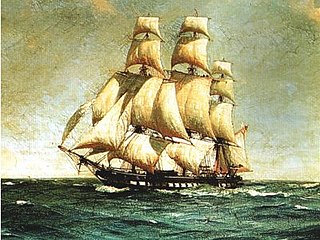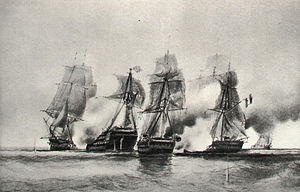Sceptre was a 74-gun ship of the line of the French Navy. Built under the Ancien Régime, she took part in the naval operations in the American Revolutionary War. At the Revolution, she took part in the main actions of the French Revolutionary Wars, notably the so-called Glorious First of June and in Bruix' expedition of 1799. Showing her age by the rise of the First French Empire, she was hulked and eventually broken up.

Brutus was a merchant ship built in 1780 at Bordeaux. She was commissioned as a privateer in 1793 at Bordeaux. However, the French Navy purchased her in September 1793 at Brest and classed her as a corvette. The French Navy later converted her to a brig. HMS Mermaid captured her on 10 October 1795.
The Aglaé was a 32-gun frigate of the French Navy, built to a design by P. Duhamel.

Régulus was a Téméraire-class 74-gun ship of the line of the French Navy.
Harmonie was a 40-gun Virginie-class frigate of the French Navy. Her crew scuttled her on 17 March 1797 to avoid having the Royal Navy capture her. She on being burned was reported as pierced for 44 guns

The Prudente was a 32-gun Capricieuse-class frigate of the French Navy.

Iphigénie was a 32-gun Iphigénie-class frigate of the French Navy, and the lead ship of her class. She was briefly in British hands after the Anglo-Spanish capture of Toulon in August 1793 but the French recaptured her December. The Spanish captured her in 1795 and her subsequent fate is unknown.

The Sunda Strait campaign of January 1794 was a series of manoeuvres and naval actions fought between warships and privateers of the French Republic and a squadron of vessels sent by the British East India Company to protect trade in the region, later augmented by Dutch warships. The campaign developed as French forces based on Île de France reacted more quickly than the British forces in the Indian Ocean to the expansion of the French Revolutionary Wars on 1 February 1793. French privateers rapidly spread along the British trade routes in the Far East, becoming concentrated around the narrow Sunda Strait between the islands of Java and Sumatra in the Dutch East Indies. These ships were soon joined by French Navy frigates and began to inflict losses on shipping in the region. The Royal Navy forces in the Indian Ocean were deployed elsewhere and so the East India Company, the private enterprise that ruled much of British India in the 1790s and maintained their own fleet and navy, raised a squadron of armed merchant ships to patrol the Strait and drive off the raiders.

L'Espoir was a French brig-sloop that served for 9½ years in the French Navy before HMS Thalia captured her in September 1797. In her subsequent short career in British service as HMS Espoir she captured three prizes, with the capture in 1798 of the more heavily armed Genoese pirate Liguria earning her crew a clasp to the Naval General Service Medal. Espoir was laid up in 1799 and sold in 1804.

Alceste was a Magicienne class frigate of the French Navy, launched in 1780, that the British seized at the Siege of Toulon. They transferred her to the Kingdom of Sardinia, but the French recaptured her a year later in the action of 8 June 1794. The British captured her again at the action of 18 June 1799 and took her into service as HMS Alceste. In 1801 she became a floating battery and she was sold the next year.

The Battle of Île Ronde was a minor naval engagement between small French Navy and British Royal Navy squadrons off Île de France, now named Mauritius, in the early stages of the French Revolutionary Wars. The battle was fought over control of the waters around Île de France, which was under blockade from the British squadron as French warships and privateers operating from the island posed a significant threat to vital British trade routes connected to British India and China.
Pandour was a French a 14-gun gun-brig launched in 1780 as a cutter. The Royal Navy captured her in December 1795 and took her into service as Pandora, but she foundered in June 1797.
Princess Royal, launched in 1786, was an East Indiaman. She made two complete trips to India for the British East India Company (EIC) and was on her third trip, this one to China, when French privateers or warships captured her on 27 September 1793. The French Navy took her into service in the Indian Ocean as a 34-gun frigate under the name Duguay Trouin. The Royal Navy recaptured her and she returned to British merchant service. In 1797 she performed one more voyage for the EIC. She received a letter of marque in July 1798 but was captured in October 1799 off the coast of Sumatra.
The action of 31 May 1796 was a small action during the French Revolutionary Wars in which a Royal Navy squadron under the command of Commodore Horatio Nelson, in the 64-gun third-rate ship of the line HMS Agamemnon, captured a seven-vessel French convoy that was sailing along the coast from Menton to Vado in the Mediterranean. The British succeeded in capturing the entire convoy, with minimal casualties to themselves.
Calypso was a 40-gun Gloire-class frigate of the French Navy, built after plans designed by Sané revised by Forfait. Under Captain Louis-Léon Jacob, she took part in the Battle of Les Sables-d'Olonne, where she sustained very severe damage.
Antoine Marie François Montalan was a French Navy officer active during the French Revolutionary Wars and the Napoleonic wars.
Réolaise was a 20-gun ship-corvette of the French Navy. Originally a British merchantman, she was built in England, and captured by the French and taken into naval service in 1793. She served as a convoy escort until she ran aground in combat in 1800 at Port Navalo; her crew scuttled her by fire.

Décius was a Société populaire-class corvette launched in 1795 in Brest. Originally named Doucereuse, she was renamed to Décius in 1795. The British Royal Navy destroyed her in November 1796.
Louis-André Senez was an officer of the French Navy during the Revolutionary and Napoleonic wars.
Louis-Marie Le Gouardun was a French Navy officer. Starting his career in the French East India Company, he served under Suffren in the Indian Ocean during the Anglo-French War, and later in important actions of the French Revolutionary Wars. He commanded Dix-Août during her victorious Action of 24 June 1801 against Swiftsure. After serving through the First French Empire, Le Gouardun was forcibly retired at the Bourbon Restoration.








